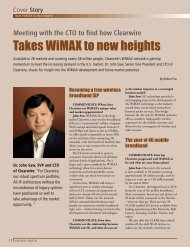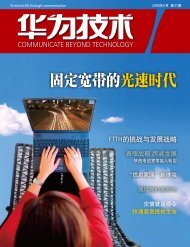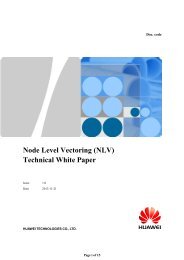EMOBILE: the mobile broadband revolutionist - Huawei
EMOBILE: the mobile broadband revolutionist - Huawei
EMOBILE: the mobile broadband revolutionist - Huawei
You also want an ePaper? Increase the reach of your titles
YUMPU automatically turns print PDFs into web optimized ePapers that Google loves.
Few people are familiar with China Mobile’s<br />
difficult past. Without implementing<br />
an All-IP strategy earlier than its rivals,<br />
<strong>the</strong> Chinese giant might be away from<br />
its rightful position as one of <strong>the</strong> globe’s leading<br />
operators.<br />
As China’s leading telecom services provider,<br />
China Mobile boasts <strong>the</strong> world’s largest <strong>mobile</strong><br />
subscriber base. Serviced by a unified, all-digital<br />
<strong>mobile</strong> network, its subscribers topped 450 million<br />
on November 30, 2008, while <strong>the</strong> number of new<br />
monthly subscribers to its services has reached a<br />
staggering 4 million. China Mobile’s GSM and<br />
GPRS global roaming services cover 219 and 138<br />
regions and countries respectively. The creative<br />
addition of value-added services has culminated in<br />
27% of its revenue deriving from non-traditional<br />
services such as CRBT, music downloads, and a<br />
range of Internet-based services.<br />
Time for a bold move<br />
2003, however, marked a year replete with<br />
difficulties for China Mobile. Market competition<br />
was cut-throat, and competitors were aggressively<br />
courting new subscribers with attractive subsidies<br />
and tariff packages. Internally, <strong>the</strong> company was<br />
saddled with a TDM-based network that was at<br />
80% capacity and betraying signs that customer<br />
demand would soon outpace its capabilities.<br />
While new domestic subscribers had grown from<br />
60 million in 2001 to 62 million in 2003, China<br />
Mobile actually lost its new subscribers during <strong>the</strong><br />
same period, suffering a sharp decline from 32<br />
million to 24 million. This was nothing short of a<br />
crisis in a market with a <strong>mobile</strong> penetration rate of<br />
only 21%.<br />
To reverse <strong>the</strong> situation, China Mobile decided<br />
to adjust its development strategy in a number of<br />
ways. Firstly, <strong>the</strong> company decided to reconstruct<br />
its network with future-oriented nascent<br />
technologies to enhance service capabilities and<br />
reduce TCO. Secondly, it sought to transform its<br />
role from a “<strong>mobile</strong> communications expert” to a<br />
“<strong>mobile</strong> information expert”.<br />
The legacy TDM network of China Mobile<br />
had been <strong>the</strong> largest <strong>mobile</strong> network in <strong>the</strong> world,<br />
providing services for 150 million subscribers a<br />
decade after its inception. Network expansion,<br />
however, would increase topology complexity,<br />
resulting in declined quality but increased ancillary<br />
costs, including <strong>the</strong> costs related to transmission,<br />
equipment rooms, power consumption, and<br />
human resources. In a bold move fraught with risk,<br />
China Mobile acted decisively and positioned All-<br />
FEB 2009 / Win-Win<br />
40

















